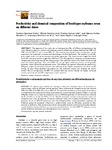Please use this identifier to cite or link to this item:
http://www.alice.cnptia.embrapa.br/alice/handle/doc/1051846| Title: | Productivity and chemical composition of food-type soybeans sown on different dates. |
| Authors: | FREIRIA, G. H.  LIMA, W. F.   LEITE, R. S.   MANDARINO, J. M. G.   SILVA, J. B. da   PRETE, C. E. C.   |
| Affiliation: | GUSTAVO HENRIQUE FREIRIA, UEL; WILMAR FERREIRA LIMA, IAPAR; RODRIGO SANTOS LEITE, CNPSO; JOSE MARCOS GONTIJO MANDARINO, CNPSO; JOSEMEYRE BONIFÁCIO DA SILVA, UEL; CÁSSIO EGÍDIO CAVENAGHI PRETE, UEL. |
| Date Issued: | 2016 |
| Citation: | Acta Scientiarum. Agronomy, Maringá, v. 38, n. 3, p. 371-377, July-Sept., 2016. |
| Description: | ABSTRACT. The objective of this study was to investigate the effect of different sowing dates on the yield, 100-grain weight, oil, protein and isoflavone contents of food-type soybean breeding lines UEL 110, UEL 115 and UEL 123 and a cultivar BRS 257. The materials were seeded on four sowing dates, and the experiment was conducted in a randomized block design with four replications. The productivity and 100-grain weight varied with the sowing dates and soybean genotypes. The protein content ranged from 36.40 to 42.44%, and the oil content ranged from 18.29 to 22.71%. No significant interaction was found between the genotype and sowing dates for the protein content. The isoflavone content also varied with the sowing dates and soybean genotypes. The cultivar BRS 257 had the highest isoflavone content, including the β- glucoside, malonyl glucoside and aglycones forms. The different sowing dates influenced the productivity, 100-grain weight, oil and protein content and isoflavone levels. Higher temperatures and lower rainfall during the grain filling decreased the productivity and isoflavone content and increased the protein content. For all sowing dates, the BRS 257 soybean food-type cultivar showed the highest isoflavone content, indicating that the effect of genotype is more important. Keywords: soybean, oil, protein, isoflavones. RESUMO. O objetivo deste trabalho foi investigar o efeito das diferentes épocas de semeadura na produtividade, massa de 100 grãos, teor de proteínas, óleo e isoflavonas de linhagens de soja tipo alimento UEL 110, UEL 115 e UEL 123 e cultivar BRS 257. O material foi semeado em quatro épocas de semeadura e o experimento foi conduzido em blocos casualizados com quatro repetições. A produtividade e a massa de 100 grãos variaram com a época de semeadura e com os diferentes genótipos. O teor de proteínas variou de 36,40 a 42,44% e o de óleo de 18,29 a 22,71%. Não foi encontrada interação entre genótipo e épocas de semeadura para o teor de proteínas. O teor de isoflavonas variou com as épocas de semeadura e com os genótipos. A cultivar BRS 257 apresentou maior teor de β-glicosídeos, malonil-glicosídeos e agliconas. As diferentes épocas de semeadura influenciam a produtividade, massa de 100 grãos, conteúdo de óleo, proteínas e isoflavonas. Altas temperaturas e baixas precipitações durante o enchimento dos grãos reduzem a produtividade e teor de isoflavonas e aumentam o teor de proteínas. A cultivar BRS 257 apresenta o maior teor de isoflavonas indicando que o efeito genético é mais importante. |
| Thesagro: | Soja Óleo vegetal Proteína vegetal |
| NAL Thesaurus: | Soybeans Isoflavones Oil crops Oilseed protein Soybean oil |
| ISSN: | 1807-8621 |
| DOI: | 10.4025/actasciagron.v38i3.28632 |
| Type of Material: | Artigo de periódico |
| Access: | openAccess |
| Appears in Collections: | Artigo em periódico indexado (CNPSO)  |
Files in This Item:
| File | Description | Size | Format | |
|---|---|---|---|---|
| 286321435611PB.pdf | 749.61 kB | Adobe PDF |  View/Open |









